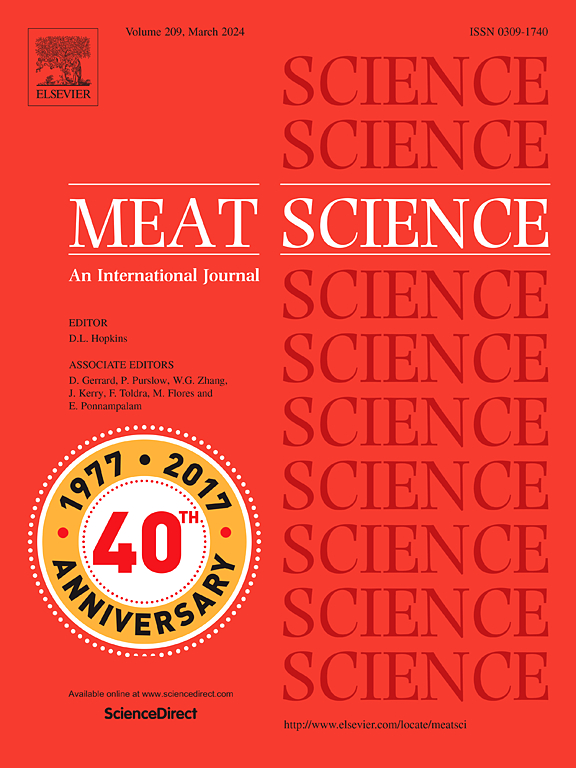Does early weaning of improved Jezersko-Solčava x Texel lambs affect growth performance, carcass traits and meat quality?
IF 6.1
1区 农林科学
Q1 Agricultural and Biological Sciences
引用次数: 0
Abstract
A total of 24 crossbred Improved Jezersko-Solčava x Texel (JSRT) lambs were included to investigate the effect of lamb age at weaning on growth performance, carcass traits, and meat quality. Lambs were randomly divided into two groups according to weaning age (early at 50 days vs. late at 75 days). Both early-weaned (6 males, 6 females) and late-weaned (6 males, 6 females) groups were fed with the same hay and concentrates ad libitum until slaughter at an average weight of 36.5 kg. The results indicated that the carcasses of early-weaned male lambs had a lower fat content than the late-weaned male lambs, however, there were no differences in carcass fatness between early- and late-weaned females. These results confirm the differences in the temporal dynamics of fat deposition between the sexes. Early weaning shortened the period from birth to slaughter by 11 days. Early weaning resulted in higher live weight gain in JSRT lambs compared to late weaning, primarily due to differences in post-weaning growth. There was no influence of weaning age on meat colour parameters, ultimate pH and sensory traits, except tenderness. Early weaning of male lambs can be recommended as it results in carcasses with less fat, without negative effects on meat or sensory quality traits, and could be economically viable for breeders.
改良jezersko - solava x Texel羔羊的早期断奶是否影响生长性能、胴体性状和肉品质?
选用24只杂交改良jezersko - solava x Texel (JSRT)羔羊,研究断奶年龄对羔羊生长性能、胴体性状和肉品质的影响。根据断奶日龄将羔羊随机分为两组(50日龄早期和75日龄晚期)。早断奶组(公6母6)和晚断奶组(公6母6)随意饲喂相同的干草和精料,直至平均体重36.5 kg屠宰。结果表明,早期断奶公羊羔的胴体脂肪含量低于后期断奶公羊羔,而早期和后期断奶母羊羔的胴体脂肪含量无显著差异。这些结果证实了两性之间脂肪沉积时间动态的差异。提前断奶缩短了从出生到屠宰的11天时间。与后期断奶相比,早期断奶导致JSRT羔羊的活重增加更高,这主要是由于断奶后生长的差异。除嫩度外,断奶日龄对肉色参数、最终pH值和感官性状均无影响。可以推荐公羊羔早期断奶,因为它导致胴体脂肪较少,对肉或感官品质性状没有负面影响,并且对育种者来说在经济上是可行的。
本文章由计算机程序翻译,如有差异,请以英文原文为准。
求助全文
约1分钟内获得全文
求助全文
来源期刊

Meat Science
工程技术-食品科技
CiteScore
12.60
自引率
9.90%
发文量
282
审稿时长
60 days
期刊介绍:
The aim of Meat Science is to serve as a suitable platform for the dissemination of interdisciplinary and international knowledge on all factors influencing the properties of meat. While the journal primarily focuses on the flesh of mammals, contributions related to poultry will be considered if they enhance the overall understanding of the relationship between muscle nature and meat quality post mortem. Additionally, papers on large birds (e.g., emus, ostriches) as well as wild-captured mammals and crocodiles will be welcomed.
 求助内容:
求助内容: 应助结果提醒方式:
应助结果提醒方式:


